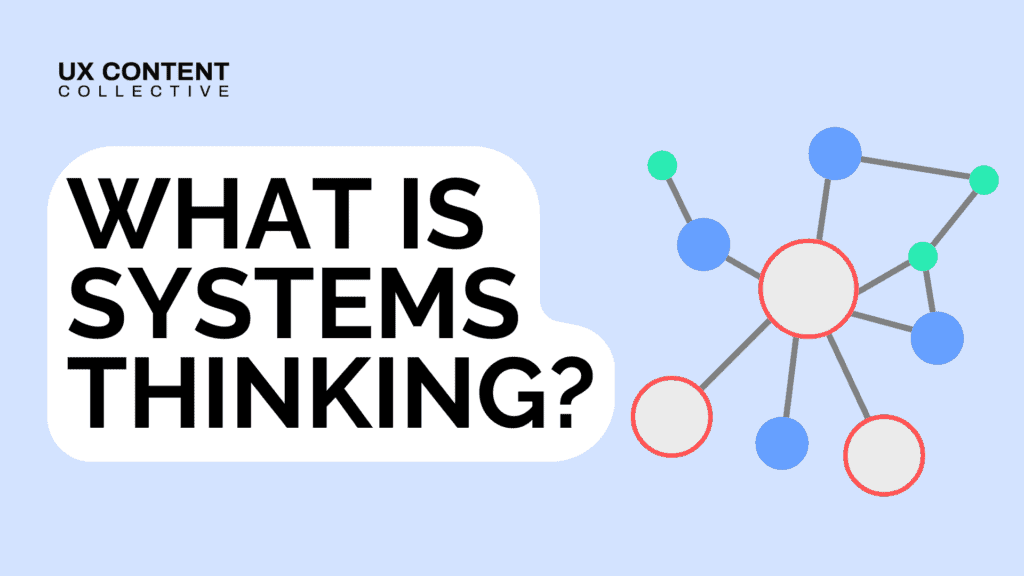
Systems thinking for UX: a guide for content designers
Patrick Stafford

Systems thinking is a way of understanding the world that focuses on how things are connected, not just how they function in isolation. Rather than zooming in on a single piece of a puzzle, systems thinking asks you to zoom out and consider the full picture.
It’s a method of problem solving and design that recognizes patterns, interdependencies, and the dynamics that arise from the relationships between parts of a whole.
There are actually a whole bunch of definitions for systems thinking in a wide range of contexts, but we’re specifically focused on UX and content.
In a traditional approach to solving problems – especially in software development or design – it’s common to tackle issues one at a time.
A button doesn’t work, so you fix the button. A user doesn’t understand an error message, so you rewrite the copy. These approaches are tactical and often necessary. But they can also lead to reactive, short-term fixes that overlook deeper structural problems.
Systems thinking shifts your mindset from reactive problem-solving to proactive pattern recognition.
What is systems thinking and why does it matter?
At its core, systems thinking teaches you to look for the inputs and outputs of a system, identify feedback loops, and understand how changes in one area can ripple out to affect other parts, often in unexpected ways. It’s not just about cause and effect, but about circular relationships, time delays, reinforcing behaviors, and systemic leverage points.
Let’s take a simple metaphor: a home garden. If you only water the plants when they look wilted, you’re responding to symptoms. But if you study the environment – how sunlight, soil quality, watering schedules, and even local insects work together – you’re thinking in systems. You’re identifying the root causes of problems and planning interventions that will be more effective, resilient, and sustainable.
In digital products, the “garden” might include content guidelines, product architecture, user journeys, localization pipelines, and design systems. And the “plants”? Every word and interaction a user sees.
Systems thinking for UX helps content designers recognize that what users see in a single interface is only the tip of a much larger iceberg. Every piece of content is downstream from a set of upstream decisions. By shifting our focus to those upstream decisions – the frameworks, processes, and principles behind the content- we begin to design not just for the user experience, but for the content system itself.
Systems thinking for content design in UX
Content is often treated as the final layer of a product. A surface-level detail that gets added once the “real” work of design and development is complete. But this view overlooks how deeply content is embedded within the systems that shape product experiences.
When we think of content as an outcome rather than a component of a system, we miss the opportunity to influence upstream decisions that directly impact how usable, scalable, and coherent our experiences can be.
In reality, content is one of the most system-dependent parts of any product. Every piece of copy, from a button label to an onboarding message, is governed by upstream structures: taxonomies, localization workflows, brand guidelines, CMS constraints, API limitations, and more.
If these systems aren’t thoughtfully designedm, or worse, if they’re invisible to the content team, content ends up being reactive. Designers and writers scramble to patch inconsistencies or write their way around structural limitations. The result? An experience that might feel disjointed, hard to scale, or difficult to maintain over time.
When content designers apply systems thinking, they stop asking only “What should this message say?” and start asking “What system produced this message? And what’s the best way to influence that system to improve outcomes?”
Take help content, for example. Without a structured approach, a team might create dozens of articles in response to support tickets, stakeholder requests, or product changes. Over time, that content becomes bloated, redundant, and difficult to navigate. But a systems-thinking approach starts with understanding user intent, grouping needs into themes, and creating modular content components that can be reused, localized, and adapted across channels.
The same applies to interface content. Writing a single error message is easy. But writing 300 consistent error messages across an enterprise app? That’s a system design problem. It requires rules, templates, logic, and alignment across teams.
Systems thinking for UX content also helps break down silos between teams. When content is embedded into a broader system view, it stops being just the “writer’s job” and becomes a shared responsibility across product, design, engineering, research, and localization. Everyone begins to see content not as a cherry on top, but as structural glue holding the experience together.
In short: thinking in systems allows content designers to move upstream, influence strategy, and solve problems at the root—not just at the surface. It transforms content from reactive output into proactive infrastructure.
Object-oriented thinking for UX content
When content designers start to think in systems, one powerful lens to adopt is object-oriented thinking. Borrowed from software engineering, this approach isn’t just about code — it’s about how digital products are fundamentally structured, and how we can align our content strategy accordingly.
In digital systems, almost everything a user interacts with can be understood as an object. Not just visually, but structurally. An object in this context is something that contains data (attributes), affords actions, and may include rules about access or permissions. For example, in a gardening app, the primary object might be “plant.” That plant object has attributes like color, size, habitat, and so on. The user, too, is an object – with attributes like email, location, and preferences – and can take actions like “add plant”.
Thinking this way reframes how we approach content design. Instead of writing text for isolated screens or flows, we start designing with the objects, their attributes, and their relationships in mind. We don’t just describe what a user sees, we shape how the system communicates around those objects. For example:
A plant object might require structured content that maps to those attributes: “This rose bush prefers damp environments.”
A user object might include microcopy that guides actions: “Save your plants to revisit later.”
By embracing object-oriented thinking, content designers can better mirror how the product is actually built. This unlocks consistency, scale, and clarity, because we’re not improvising per screen. We’re defining patterns for how objects are described, how actions are conveyed, and how relationships are expressed.
This mindset also helps clarify where content ends and where systems begin. It prevents us from chasing UI-level fixes and pushes us to think deeper: what’s the object here? What attributes matter? What actions need support?
In a world where AI and rapid prototyping accelerate the rate of product change, aligning content strategy with object architecture is what ensures coherence over time. This is how we build durable content systems that can flex and scale, not just copy that works for today.
Why systems thinking matters more as products grow complex
As products evolve into ecosystems, systems thinking for UX becomes essential. A product isn’t just a single app screen – it’s a constellation of touchpoints: mobile apps, web portals, automated emails, notifications, help content, chatbots, and even generative AI assistants. Users don’t just complete tasks; they navigate a network of interactions, each with its own set of expectations, limitations, and contextual needs.
In this environment, content can no longer be designed screen by screen or ticket by ticket. Writing decisions made in isolation—without regard for other systems—lead to duplicated work, user confusion, and poor scalability. A new feature might launch quickly, but without integration into a broader content system, it adds to the chaos rather than improving the experience.
This isn’t just a theoretical risk. As product teams move faster and deploy more frequently, the content debt builds. Inconsistent naming conventions. Duplicated patterns. Contradictory guidance. Every workaround adds up — and over time, you end up with a system that’s harder to maintain, test, localize, or scale.
Applying systems thinking to content design work
Content designers who embrace systems thinking help future-proof the product. They ask foundational questions: How will this scale across markets? How will this change when a user’s context shifts? What templates, structures, or logic can we apply to reduce manual effort later?
This mindset is about resilience. The more unpredictable the environment, the more value a well-structured system brings. Teams that invest in content systems like terminology libraries, reusable content patterns, documentation standards, and logic-driven frameworks, are able to ship faster, collaborate better, and adapt more easily when priorities shift.
AI is introducing new types of interaction. Multimodal interfaces are becoming standard. Personalization is expected. Without a system-first approach, content teams will be stuck reacting to change rather than shaping it.
And while other disciplines also build systems – engineers with code, designers with components – content often slips through the cracks. Unlike UI elements, text isn’t always treated as something that can be templated or reused. That’s a missed opportunity. Because content is so deeply tied to user understanding, behavior, and trust, content systems have an outsized impact on product cohesion.
Examples of systems thinking in content design
Content designers can take ownership here in a few key ways:
-
Standardizing patterns: Things like success messages, onboarding steps, and confirmation flows can all follow reusable models. When these are documented and embedded in design systems, it reduces duplication and improves clarity across experiences.
-
Building shared libraries: Terminology glossaries, writing principles, voice and tone guides — these are foundational systems that ensure alignment not just within content teams but across the entire product org.
-
Designing with logic in mind: Systems thinking encourages content designers to consider how content appears dynamically. What happens when variables change? How does content adapt based on user behavior or platform constraints? Thinking in terms of logic and branching unlocks smarter, more flexible experiences.
-
Leading cross-functional collaboration: Because content systems affect localization, accessibility, and engineering, content designers can serve as a hub for aligning multiple teams around scalable practices.
- Think architecturally about objects and concepts: Specifically, you need to think about how objects and concepts are represented with words in your product.
Most importantly, systems thinking allows content designers to move upstream. When you’re seen as the person who improves process, increases velocity, and reduces risk, your role shifts from reactive to strategic. Instead of waiting for Jira tickets, you’re helping define the architecture that shapes how content works across the product.
Teams that treat content as part of their product infrastructure are seeing better outcomes: more consistency, faster iteration, clearer user journeys.
Systems thinking for UX is essential for success
Systems thinking for UX shifts content designers from short-term fixes to long-term impact. It helps teams move faster without losing clarity. And it gives content professionals a seat at the table — not just as writers, but as architects of the user experience.
This isn’t a niche skill. It’s foundational. Whether you’re defining message logic, building libraries, or collaborating on design systems, systems thinking lets you operate at scale and with purpose.
Frequently asked questions about systems thinking
What is systems thinking in UX content design?
Systems thinking is an approach that helps content designers understand how different parts of a product or service work together. It emphasizes seeing the bigger picture, identifying interdependencies, and designing content that fits within complex ecosystems.
Why is systems thinking important for content designers?
Content designers often work across multiple features, teams, and touchpoints. Systems thinking helps them design scalable, consistent content solutions and avoid solving problems in isolation.
How can I apply systems thinking to my content work?
You can apply systems thinking by mapping content flows, identifying shared components, designing for reuse, and collaborating closely with cross-functional teams to ensure alignment across the product.
Is systems thinking only for large organizations or complex products?
No. Even in small teams or simpler products, systems thinking can help you anticipate future needs, avoid duplicate work, and create a more cohesive user experience.
Where can I learn more about systems thinking in UX?
Check out resources like Thinking in Systems by Donella Meadows, or our Advanced UX Content for Product course, which includes a unit on systems thinking for content designers.




